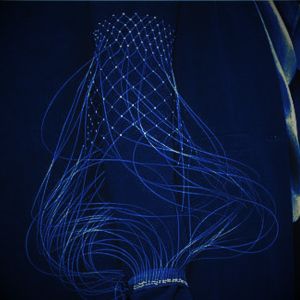8. Wearables¶
Research¶

AIR LOGIC: is a technique to create electronics-free, interactive objects by embedding pneumatic input, logic processing, and output widgets in 3D-printable models. AirLogic devices can perform basic computation on user inputs and create visible, audible, or haptic feedback; yet they do not require electronic circuits, physical assembly, or resetting between uses
FLUID FIBERS: with fluid flowing in a tube, is an attractive material to flexibly and dynamically display digital information. While it has recently attracted attention from the HCI field, there is currently little knowledge about this material, limited to controlling the position of the droplets to present representational information like letters and numbers. To develop a broader and deepened understanding of this material and its potential for display design.
MECHANOTRANSDUCTION: is the process by which physical forces are sensed and converted into biochemical and electrical signals that then result in cellular responses.
KINESTETIC: refers to movement that involves the sense of touch or bodily movement. It is often used in the context of learning styles, where kinesthetic learners prefer to learn through hands-on activities and physical movement
weekly assignment
Check out the weekly assignment here or login to your NuEval progress and evaluation page.
wearables advances
-
AlterWear - Battery-Free Wearable Displays for Opportunistic Interactions
-
remember to resize and optimize all your images. You will run out of space and the more data, the more servers, the more cooling systems and energy wasted :) make a choice at every image :)
This image is optimised in size with resolution 72 and passed through tinypng for final optimisation. Remove tips when you don't need them anymore!
get inspired!
Check out and research alumni pages to betetr understand how to document and get inspired
- Emma Shannon
- Elena Rotaru
- Diane Wakim Le TextileLab Lyon 2020-21_
- Vicky Luan
- Loes Bogers TextileLab Amsterdam 2019-20_
- Sara Alvarez TextileLab Amsterdam 2020-21_
- Kate Reed
Add your fav alumni's pages as references
References & Inspiration¶
- Two images side-by-side


Tools¶
Tools¶
Process and workflow¶
My sketches are ...

This schematic 1 was obtained by..
This tutorial 2 was created using..
footnote fabrication files
Fabrication files are a necessary element for evaluation. You can add the fabrication files at the bottom of the page and simply link them as a footnote. This was your work stays organised and files will be all together at the bottom of the page. Footnotes are created using [ ^ 1 ] (without spaces, and referenced as you see at the last chapter of this page) You can reference the fabrication files to multiple places on your page as you see for footnote nr. 2 also present in the Gallery.
Code Example¶
Use the three backticks to separate code.
// the setup function runs once when you press reset or power the board
void setup() {
// initialize digital pin LED_BUILTIN as an output.
pinMode(LED_BUILTIN, OUTPUT);
}
// the loop function runs over and over again forever
void loop() {
digitalWrite(LED_BUILTIN, HIGH); // turn the LED on (HIGH is the voltage level)
delay(1000); // wait for a second
digitalWrite(LED_BUILTIN, LOW); // turn the LED off by making the voltage LOW
delay(1000); // wait for a second
}
Results¶

Video¶
From Vimeo¶
Sound Waves from George Gally (Radarboy) on Vimeo.